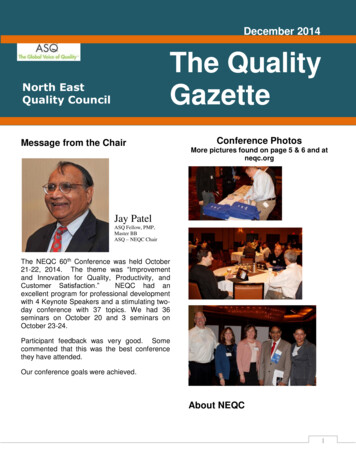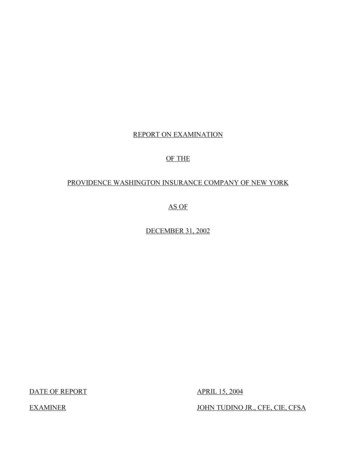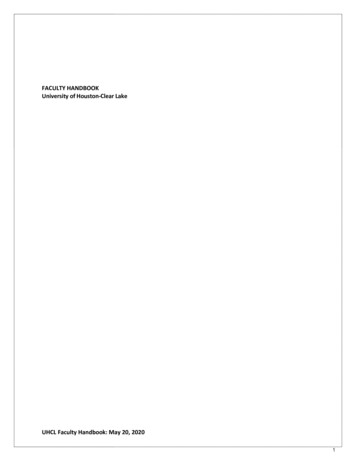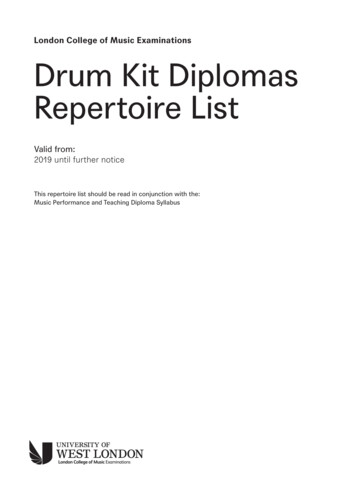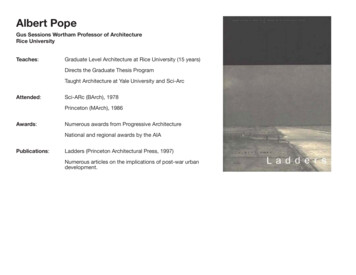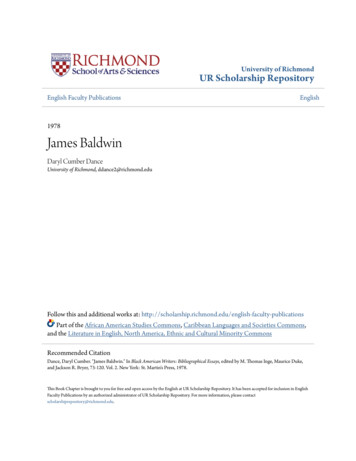
Transcription
University of RichmondUR Scholarship RepositoryEnglish Faculty PublicationsEnglish1978James BaldwinDaryl Cumber DanceUniversity of Richmond, ddance2@richmond.eduFollow this and additional works at: blicationsPart of the African American Studies Commons, Caribbean Languages and Societies Commons,and the Literature in English, North America, Ethnic and Cultural Minority CommonsRecommended CitationDance, Daryl Cumber. "James Baldwin." In Black American Writers: Bibliographical Essays, edited by M. Thomas Inge, Maurice Duke,and Jackson R. Bryer, 73-120. Vol. 2. New York: St. Martin's Press, 1978.This Book Chapter is brought to you for free and open access by the English at UR Scholarship Repository. It has been accepted for inclusion in EnglishFaculty Publications by an authorized administrator of UR Scholarship Repository. For more information, please contactscholarshiprepository@richmond.edu.
JAMES BALDWINDARYL DANCEJames Baldwin is one of America's best known and most controversialwriters. If there is some figurative truth in his declarations "NobodyKnows My Name" and "No Name in the Street," on a realistic levelpractically everyone knows his name, from people on the street toscholars in the most prestigious universities-and they all respond tohim. Those responses are as diverse and as antithetical as the respondents. Indeed, there is little unanimity in the criticism of James Baldwin: some view him as a prophet preaching love and salvation, othersas a soothsayer forecasting death and destruction; some see him as acivil-rights advocate writing protest literature, others as an artist imaginatively portraying the plight of the black American or the alienatedman. This essay considers many of these varied responses to JamesBaldwin, the man; James Baldwin, the spokesman for the black people;James Baldwin, the essayist; and James Baldwin, the novelist.BibliographyThe most helpful and complete bibliographies of Baldwin have appeared in the Bulletin of Bibliography. Kathleen A. Kindt's "James Baldwin: A Checklist: 1947-1962" (BB, January-April 1965) and Russell G.Fischer's "James Baldwin: A Bibliography, 1947-1962" (BB, JanuaryApril 1965) cover the same years and should be used together inasmuch as the items not included in one are generally found in the other;together they represent a reasonably accurate and complete bibliography through 1962. Fred L. Standley's "James Baldwin: A Checklist1963-1967" (BB, August 1968) is designed to supplement the twopreviously cited bibliographies. Standley's work, however, is not as thorough and accurate a compilation of Baldwin materials as the checklistsby Kindt and Fischer. He omits numerous reviews and articles by andabout Baldwin that appeared in such publications as Phylon, Freedomways, and Negro Digest; and his checklist has a few errors in dates andtitles. All three of these bibliographies contain listings of novels, plays,short stories, articles, and essays by Baldwin as well as reviews, criticisms, and articles about Baldwin.A much less accurate bibliography is Mary E. Jones's "James Bald-73
74Black American Writerswin," which was prepared as a class project at Atlanta University. It waspublished by the Center for African and African-American Studies(CAAS) of Atlanta University as CAAS Bibliography No. 5. Some of theentries are incomplete; parts of titles and names of periodicals aresometimes omitted, and there are several errors in this work; but it maybe worth consulting because it includes at least one item publishedprior to 194 7 which is not included in the other bibliographies andbecause it also contains a listing of Baldwin manuscripts in the TrevorArnett Library at Atlanta University.Shorter Baldwin bibliographies have appeared in other longer works.Darwin T. Turner includes a limited but helpful sixty-four-item listingof Baldwin biography and criticism in his Afro-American Writers (NewYork: Appleton, 1970). Articles on American Literature, 1950-1967, compiled by Lewis Leary (Durham, N.C.: Duke University Press, 1970),contains a helpful and reasonably complete listing of articles aboutBaldwin that appeared during the years covered. Stanley Macebuh includes a "Selected Bibliography" in his James Baldwin: A Critical Stud)'(New York: Third Press-Joseph Okpaku, 1973), but the basis for hisselections is not clear. He chooses, for example, the checklists mentioned above by Fischer and Kindt, but omits the more recent one byStandley. Further, although he omits Nothing Personal, as well as otheritems dealing directly with Baldwin, he includes several works whichtreat Baldwin only peripherally and some which do not deal with himat all. He frequently gives only the volume number of periodicals without indicating the date or pages, information that would be most helpful in locating articles. Finally, his bibliography is not always a model ofaccuracy. The first item, for example, contains two mistakes: the author's name is misspelled and the volume number of the periodical isincorrect. Other errors include the confusing of the years of publication of Another Country and The Fire Next Time. Keneth Kinnamon includes a very short but nonetheless helpful bibliography injames Baldwin: A Collection of Critical Essays (Englewood Cliffs, N.J.: Prentice-Hall,1974). All forty-one items listed are directly relevant to Baldwin, and afew more recent publications are included that cannot be found in anyof the other bibliographies. Some of the omissions are glaring, however, such as the exclusion of Robert Bone's significant study, "TheNovels of James Baldwin," in The Negro Novel in America, rev. ed. (NewHaven, Conn.: Yale University Press, 1965). Donald B. Gibson alsoincludes a reasonably good Baldwin bibliography in his Five BlackWriters (New York: New York University Press, 1970). Another satisfactory guide to Baldwin materials is Blacks in America: Bibliographical Essays, edited by James M. McPherson et al. (Garden City, N.Y.: Doubleday, 1971), although it is certainly not convenient or handy, becauseentries for Baldwin appear in several different places.
James Baldwin75Several anthologies of black American literature include brief Baldwin bibliographies. However, some of them are quite limited, such asthe one in Ruth Miller's Blackamerican Literature: 1760-Present (BeverlyHills, Calif.: Glencoe Press, 1971), which lists only three works aboutBaldwin. On the other hand, Black Writers of America: A ComprehensiveAnthology, by Richard Barksdale and Keneth Kinnamon (New York:Macmillan, 1972), contains an excellent Baldwin bibliography.EditionsFULL-LENGTH WORKSWith the exception of Nothing Personal ( 1964, with Richard Avedon), allof Baldwin's full-length works are now in print; and all, except TheAmen Corner (1968), One Day When I Was Lost (1973), and The Devil FindsWork (1976), are available in paperback. With the exception of Notes ofa Native Son ( 1955), available in paperback from Bantam aud Beacon; ADialogue (1973), from Lippincott; and If Beale Street Could Talk (1974),from the New American Library, Baldwin's paperback works are published by Dell in New York, with Go Tell It on the Mountain also availablein a Classroom Library Series in paperback, with teacher notes, fromNoble.All hardback editions of Baldwin's works now in print are from Dial,with the exception of A Rap on Race (with Margaret Mead, 1971) and ADialogue, both of which are available from Lippincott. In addition, alarge-type edition of The Fire Next Time is published by Franklin Watts.SHORT STORIESMost of Baldwin's short stories have been collected in Going to Meet theMan (New York: Dial, 1965), or have appeared as chapters in his novels. His "Death of the Prophet" (Commentary', March 1950) is a notableexception; nonetheless, it is a fictionalized account of Johnnie's visit tohis father's deathbed, obviously based upon and closely paralleling theaccount of Baldwin's visit to his father's deathbed in "Notes of a NativeSon" (Notes of a Native Son [New York: Beacon, 1955]). ··Exodus"(American Mercury, August 1952) and "Roy's Wound" (New World Writing, November 1952) are incorporated into Go Tell It on the Mountain(New York: Dial, 1953). "Any Day Now" (PR, Spring 1960) and "EasyRider" (The Dial: An Annual of Fiction [New York: Dial, 1962]) areincorporated into Another Country (New York: Dial, 1962). "The AmenCorner" (Zero, July 1954) appears as Act I of the complete work TheAmen Corner (New York: Dial, 1968).
76Black American WritersESSAYSSeveral of Baldwin's essays have been collected and appear in his fourvolumes of essays as well as in numerous other collections both in theUnited States and abroad. Many others have not appeared in his owncollections, however, although they demand attention from the Baldwin scholar because they give additional information about his views onworld events, his contemporaries, and art and the artist, and supplybiographical data. A brief chronological scanning here will give animpression of the variety of subjects that have concerned him over theyears.Baldwin's frequently quoted review of Langston Hughes's SelectedPoems, "Sermons and Blues" (NYTBR, March 29, 1959), for example,suggests a changing attitude toward protest literature. "A Word FromWriter Directly to Reader" in Fiction of the Fifties: A Decade of AmericanWriting, (edited by Herbert Gold [Garden City, N.Y.: Doubleday,1959]) is a very slight piece, a mere two paragraphs, but Baldwin comments there about the difficulty of remaining in touch with the privatelife that is the key to his achievements as a writer. He comments againon the artist's dilemma in "Mass Culture and the Creative Artist: SomePersonal Notes" (Daedalus, Spring 1960). "They Can't Turn Back" (Mademoiselle, August 1960) recounts his visit to Florida A&M Universityduring the school integration crisis and includes some revealing accounts of his reaction to the South and the effects of segregation onAmerican education. "The Dangerous Road Before Martin LutherKing" (Harper's Magazine, February 1961) recalls his first meeting withand his reactions to King. "The New Lost Generation" (Esquire, July1961) discusses the quest for identity of American expatriates in Europe. This essay contains one of Baldwin's early rejections of the possibilities of love; here he notes that during a discussion in which it wasstated that there were few decent people in the world, a friend askedhim what about love, and he replied, "Love! You'd better forget aboutthat, my friend. That train has gone." (It may also be significant thatthis young friend of twenty-four committed suicide by jumping fromthe George Washington Bridge.)In "As Much Truth as One Can Bear" (NYTBR, January 14, 1962),Baldwin discusses the importance of the novelist's being truthful.Again, in "The Artist's Struggle for Integrity" (Liberation, March 1963),he speaks of the difficulties of being an artist in the United States."Color" (Esquire, December 1962) is a rather mundane article whichmay nonetheless be of interest for Baldwin's view of the meaning ofcolor and colored and his comparison of the pursuit of happiness byblacks and whites. "At the Root of the Negro Problem" (Time, May 17,1963) details Baldwin's views on race relations in the United States and
James Baldwin77his thesis that the Negro problem stems from the myths created bywhites. "Letters from a Journey" (Harper's Magazine, May 1963) recordshis despair as he tried to complete Another Country and "Down at theCross." Here he also reveals his thoughts on the Israeli-Arab conflict,and this in turn evokes some of his views on religion and the suppression of man by man. Very important in a consideration of Baldwin theman is the idea expressed in this essay of homelessness and the questfor a home, motivated by his visit to Europe; although perhaps morerelevant to him personally is the revelation of his many thoughts on hisforthcoming visit to Africa and all that it signifies to him in terms of thequest for a home. In "We Can Change the Country" (Liberation, October 1963), Baldwin again attacks racism in the United States andurges revolution-not armed, but economic. "A Talk to Teachers"(SatR, December 21, 1963; reprinted in Education and Social Crisis: Perspectives on Teaching Disadvantaged Youths, edited by Robert Fulton andW. E. Gardner [New York: Wiley, 1967]) speaks of the lack of a truesense of identity among Americans, particularly blacks, and Baldwinchallenges teachers to educate children to examine society and to try tochange it, despite the risks involved. "What Price Freedom?" (Freedomways, Spring 1964) is a plea for freedom in the United States followingthe murders of President John F. Kennedy, Medgar Evers, and theBirmingham Sunday school girls. Here, as elsewhere, Baldwin emphasizes the need for whites to learn to regard blacks as human beings."Theatre: The Negro In and Out" (ND, April 1966) presents Baldwin's argument that the theater reflects the American confusion, whichin turn results from the effort to avoid dealing with the Negro as aperson. He comments extensively about the fact that black actors mustplay roles that are not true, and are thus forced to !Jerpetuate the popular image of the Negro. Baldwin also talks at some length about EdwardAlbee's The Death of Bessie Smith and The American Dream, both of whichhe feels left something to be desired despite their great promise.Several instances of police brutality in Harlem are cited by Baldwinin "To Whom It May Concern: A Report from Occupied Territory"(The Nation, July 11, 1966; reprinted in Law and Resistance: AmericanAttitudes Toward Authority, edited by Laurence Veysey [New York:Harper & Row, 1970) ); here he describes the anguish of helpless blacksat the mercy of cruel policemen and the resulting lack of re pect forthe law. He returns to the plight of the artist in "The Creative Dilemma" (SatR, February 8, 1967), where he details the role of the artist(obviously the role he has assumed), declaring that the artist has theresponsibility to "never cease warring with [society] for its sake and forhis own."Baldwin comments on the controversial subject of Negro-Jewishrelationships in "Negroes Are Anti-Semitic Because They're Anti-
78Black American WritersWhite" (New York Times Magazine, April 9, 1967; reprinted in BlackAnti-Semitism and Jewish Racism, introduction by Nat Hentoff [NewYork: Richard W. Baron, 1969] ). He explains that anti-Semitismamong black people is really a result of their hatred of whites, notingthat Jews have been a part (a visible part in the role of landlords,merchants, and the like) in the exploitation of blacks. He utterly rejects efforts to compare the Jews' plight or suffering with that of theblack man in America."The War Crimes Tribunal" (Freedomways, Summer 1967) is an explanation of (and something of an apology for) his signing Lord Bertrand Russell's War Crimes Tribunal. He apologizes for its possible useby Europeans to condemn America and ignore their own guilt in thewar in Vietnam and in South Africa or Rhodesia; but he explains thathe had to register his reaction against a totally indefensible Americanparticipation in the Vietnamese war. In "From Dreams of Love toDreams of Terror" (in Natural Enemies? Youth and the Clash of Generations, edited by Alexander Klein [Philadelphia: Lippincott, 1969] ),Baldwin attempts to explain, using Stokely Carmichael as a point ofreference, how young blacks dreamed of love during the civil rightsmovement, but how and why they moved toward a new militancy thatterrified the country.Baldwin returns to a favorite thesis-that history is present in all ofus and in all we do-in "Unnameable Objects, Unspeakable Crimes" (inBlack on Black: Commentaries by Negro Americans, edited by Arnold Adoff[New York: Macmillan, 1968]). He contends that the United States andthe world are menaced because white Americans have been unable toaccept their history and continue to defend themselves against it. Hespeaks also of his personal difficulty-by extension the difficulty ofblack Americans-in wrestling with his history and accepting it in orderto find his identity. Elsewhere, Baldwin attacks Western Christianity asbeing racist and hypocritical and as failing to live up to its own principles, ("White Racism or World Comr unity?" [Ecumenical Review, October 1968; reprinted in Information Service, February 22, 1969, andReligious Education, September-October 1969]). This essay is the text ofan address delivered by Baldwin at the Fourth Assembly of the WorldCouncil of Churches in Uppsala, Sweden, in the summer of 1968.Later, upon the occasion of Lorraine Hansberry's death, Baldwin reminisces rather sentimentally about his friendship with her in "SweetLorraine" (Esquire, November 1969) and briefly considers the effects ofher works on black people.Baldwin's own growing militancy is reflected in "An Open Letter toMy Sister, Miss Angela Davis" (Black Creation, April 1972), as he pictures the same kind of adulation for militant blacks as he once registered for the Martin Luther Kings. The letter, addressed to the then-
James Baldwin79imprisoned Angela Davis, treats her plight in terms of the generalracial situation in America and glories in the generation of Angela,Huey Newton, and George Jackson, "a whole new generation of people[who] have assessed and absorbed their history, and, in that tremendous action, have freed themselves of it and will never be victimsagain." Although he admits being of another generation, he asserts thathis destiny is inextricably interwoven with that of the Angela Davises;and he concludes with the memorable passage from which Angela Davis borrowed the title of her later book, If They Come in the Morning:then we must fight for your life as though it were our own-which it is-andrender impassable with our bodies the corridor to the gas chamber. For, ifthey take you in the morning, they will be coming for us that night.INTERVIEWS AND DISCUSSIONSBecause Baldwin has become a figure of wide public popularity andeven notoriety, he has appeared frequently on television and radioshows and has been interviewed by numerous popular magazines,where the interest was as much in his social and political views as in hisliterary works. In addition to A Rap on Race, a discussion with MargaretMead (Philadelphia: Lippincott, 1971), and A Dialogue, with Nikki Giovanni (Philadelphia: Lippincott, 1973), numerous discussions and interviews have been published in various periodicals.Baldwin participated in a symposium at Hofstra University in Hempstead, New York, in May 1961 with Ben Shabra and Darius Milhaud,moderated by Malcolm Preston, which has been published as "TheImage: Three Views" (Opera News, December 8, 1962). In this symposium, Baldwin talks about the disorder in the world, the individual'squest for identity, and the need for the individual to understand hishistory in order to know who he is."The Negro in American Culture" (Cross Currents, Summer 1961;reprinted in Mathew H. Ahmann, The New Negro [Notre Dame, Ind.:Fides, 196l];ND, March 1962; and The Black American Writer, Volume I:Fiction, edited by C. W. E. Bigsby, [Deland, Fla.: EverettJEdwards,1969]) records a discussion originally broadcast over Pacifica Radio(WBAI-FM) in 1961 among Baldwin, Alfred Kazin, Lorraine Hansberry, Emile Capouya, and Langston Hughes, moderated by Nat Hentoff. The participants discuss the conflict between the social and artisticresponsibilities of black writers, prejudices facing black artists, andwhite portrayals of black characters (particularly those of WilliamFaulkner), and comment generally about black-white relationships andthe future of America.In his interview with Baldwin ("James Baldwin Talks with KennethClark," in The Negro Protest [Boston: Beacon, 1963] ), Kenneth Clark
80Black American Writerselicits some interesting information about the subject's youth, his familyand its southern background, his education, the contemporary racialsituation, and his views of Martin Luther King and Malcolm X.Anyone interested in Baldwin the man will find the interview conducted by Eve Auchincloss and Nancy Lynch, "Disturber of the Peace:James Baldwin" (Mademoiselle, May 1963; reprinted in Bigsby, The BlackAmerican Writer, Vol. I), most helpful. Although the interview does notdeal specifically with any of his books, it touches very directly on manyideas he treats and that are of great personal interest to him, and theauthor speaks of them very honestly and eloquently. He comments onwhite liberals, his travels through the South, school desegregation, therole of sex in white people's reactions to blacks, his view of himself, andhomosexuality.The racial situation in America is discussed in "Pour Liberer lesBlancs" [To Liberate White People] (Preuves, October 1963). In a debate held at Cambridge University and published as "The AmericanDream and the American Negro" (New York Times Magazine, March 7,1965), Baldwin and William F. Buckley, Jr., debate the thesis, "TheAmerican Dream is at the expense of the American Negro." In a discussion with James Mossman and Colin Macinnes, televised and recorded by the British Broadcasting Corporation (B.B.C.) and publishedas "Race, Hate, Sex, and Colour: A Conversation" (Encounter, July1965 ), Baldwin speaks of religion and human relationships and interactions, particularly between blacks and whites in America. He also comments on his hatred of his father and his early hatred of whites (notingthat such hatred is destructive) and rejects the teachings of Malcolm X.Later, Baldwin talks of his need to write, and the necessity of beingaway from America in order to write, in an interview first published inCEP Dergisi (Istanbul) and reprinted in Atlas (March 1967), "JamesBaldwin Breaks His Silence." He also comments on Black Power, thewar in Vietnam, and Christianity, expressing views similar to those hehas expressed elsewhere on these subjects.In an interview published as "How Can We Get the Black People toCool It?" (Esquire, July 1968), Baldwin enumerates the causes of thestreet riots that had recently occurred, and bitterly attacks policemenand politics in America, although he still expresses hope for the UnitedStates and advises young blacks not to hate white people. On March 18,1968, he appeared with Betty Shabazz at a hearing held in New YorkCity before the House of Representatives' Select Subcommittee On Labor on the subject of establishing a National Commission on NegroHistory and Culture. He supported the establishment of the commission, but cautioned that blacks cannot be taught their culture untilAmerican history is truthfully taught and until textbooks are changed,so that the view of American history will no longer destroy the morals
James Baldwin81of black children by distorting their past. The transcript of this testimony is published as "The Nigger We Invent" (Integrated Education,March and April 1969).In "Conversation: Ida Lewis and James Baldwin" (Essence, October1970), Baldwin explains why he had to leave America. He claims thathis role of spokesman, which he never wanted, is over now. In a laterinterview with David Frost, "Are We on the Edge of Civil War?" (inDavid Frost, The Americans [New York: Stein & Day, 1970]), Baldwinspeaks bitterly about race relations in America and discusses the revolutionary impulse among black militants.The interview with Herbert R. Lottman, "To Be James Baldwin"(Intellectual Digest, July 1972), records the growing bitterness Baldwinreflected in his then recently published No Name in the Street (NewYork: Dial, 1972). He notes that his attitude toward the world haschanged: "I'm much sadder now," and contends that he sees a holocaust approaching; he says that No Name in the Street is about this holocaust. Although the book documents the civil rights movement up tothe death of Martin Luther King, Baldwin declares "It's not a documentary. It's a personal book-my own testimony." In a bitter, premonitory tone he explains what he means by holocaust: "Americans whohave managed to learn nothing are now about to learn a great deal."A sometimes frustrating record of the fiery debate between Peregrine Worsthorne and James Baldwin may be found in Encounter ("LetMe Finish, Let Me Finish . " [September 1972] ). This unedited transcript is often unclear and confusing because key words are frequentlyomitted. In this heated debate, chaired by Bryan Magee and broadcastas part of Thames Television's Something to Say series, Worsthorne contends that American blacks are largely responsible for their own fatebecause they have not taken advantage of opportunities the way otherminorities have. As Baldwin vehemently rejects this assertion, there is agreat deal of screaming but little communication between the two, because Worsthorne cannot understand Baldwin's historical perspective,which allows him to allude to all blacks, slaves, and those in similarconditions as "I," and to refer to all whites, slaveholders, and their likeas "you."A series of interviews with Joe Walker ("Exclusive Interview withJames Baldwin" [Muhammad Speaks, September 8, 15, 22, 29, 1972]),found Baldwin speaking about the lack of representation of blacks inthe government, the renaissance in black American literature, andblack films. The next year, in an unpublished television interview onthe Dick Cavett Show (September 5, 1973), Baldwin spoke about hisforthcoming If Beale Street Could Talk (New York: Dial, 1974) and insisted that he had found himself: "Certain battles I've been fighting inmyself are beginning to end." "The Black Scholar Interviews: James
82Black American WritersBaldwin" (BlackSch, December-January 1974) is an interesting discussion of many subjects on which Baldwin has commented elsewhere,including the present world political scene and Lorraine Hansberry.Baldwin also emphasizes here the importance of a strong and lovingblack family for survival.A recent interview with inmates at Riker's Island prison in New York(Essence, June 1976) is notable for its calmness. Baldwin appeals to thewomen "to save our children," and speaks poignantly of his father,"without [whom] I might be dead." Though he still predicts the fall ofWestern civilization, his prophesies are couched in the mildest language.Manuscripts and LettersLocating Baldwin manuscripts and letters is a frustrating task, partlybecause Baldwin has little interest in retaining and preserving hismanuscripts, according to two of his friends with whom I spoke (SamFloyd, at Atlanta University, Atlanta, Georgia, in March 1972; andAlex Haley, at Virginia Commonwealth University, Richmond, Virginia, on September 30, 1974) and according to some of his owncomments. In a letter to Harold Jackman (1956) Baldwin gave hispermission for the manuscript of Giovanni's Room to be given to Atlanta University, noting that he'd 'just as soon never lay eyes on itagain." Further, Fern Eckman has noted that the manuscript of anunpublished novel, Ignorant Armies, is "now reposing in a duffte bag inhis mother's apartment" (The Furious Passage of James Baldwin [Philadelphia: Lippincott, 1966] ).Nothing is cited for Baldwin in Lorenzo Greene's "Negro ManuscriptCollections in Libraries" (NHB, March 1967); in Philip M. Hamer's A,.; Guide to Archives and Manuscripts in the United States (New Haven, Conn:Yale University Press, 1961 ); or in American Literary Manuscripts (Austin:University of Texas Press, 1960), compiled by the Modern LanguageAssociation of America, American Literature Group, Committee onManuscript Holdings. The United States Library of Congress's NationalUnion Catalog of Manuscript Collections mentions only the manuscripts atAtlanta University, which will be cited shortly.Walter Schath's Directory of Afro-American Resources (New York:Bowker, 1970) is the only reference that lists several Baldwin manuscripts, but all of these cannot at this time be located. Schath indicatesthat the American Academy of Arts and Letters Library in New YorkCity has about twenty items. A request for a description of these itemswas answered by Hortense Zera, the librarian (in a letter dated October10, 1974), who indicated that they had two typed letters, one "concerning invitations he [Baldwin] wanted sent to family members for theceremonial at which he was given his grant in 1956" and the other "toW. H. Auden, chairman of the committee, thanking him for the grant."
James Baldwin83Schath also indicates that the Museum of African American History at3806 South Michigan Avenue, Chicago, Illinois, holds taped speeches,interviews, and the like; but there is not now such a museum at thataddress, nor is a museum by that name listed in the Chicago telephonedirectory. Finally, Schath indicates that there are tapes Baldwin madefor radio broadcast at SCLC Radio in New York City; that radio stationis not now at the address listed by Schath, nor is it listed in the telephone directory.Apparently, the only significant collection of Baldwin manuscripts isat the Trevor-Arnett Library at Atlanta University. These manuscriptswere secured through the Harold Jackman Memorial Committee, ofwhich Baldwin is a member. Because the manuscripts in the CounteeCullen Memorial Collections at the Trevor-Arnett Library constitutepractically all of this discussion on manuscripts and because they are sofascinating to the Baldwin scholar, a detailed description of them seemsappropriate. They include:A holograph note explaining the purpose of Giovanni's Room-toshow "the near impossibility of love in our time-between men,or between men and women"-and outlining the plan of thebook, with additional notes on technique.2. Several other pages of notes regarding Giovanni's Room, concerning matters such as the placement of the description of the roomso as to achieve the greatest symbolic significance, and a consideration of the effects Baldwin wishes to achieve in particularscenes and episod
account of Baldwin's visit to his father's deathbed in "Notes of a Native Son" (Notes of a Native Son [New York: Beacon, 1955]). ··Exodus" (American Mercury, August 1952) and "Roy's Wound" (New World Writ ing, N
